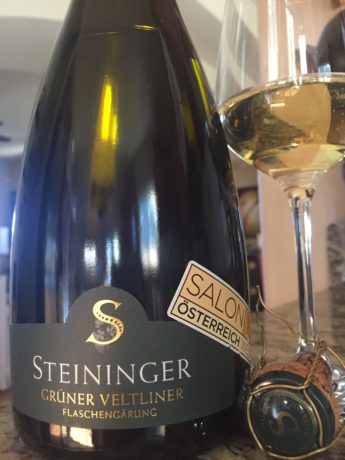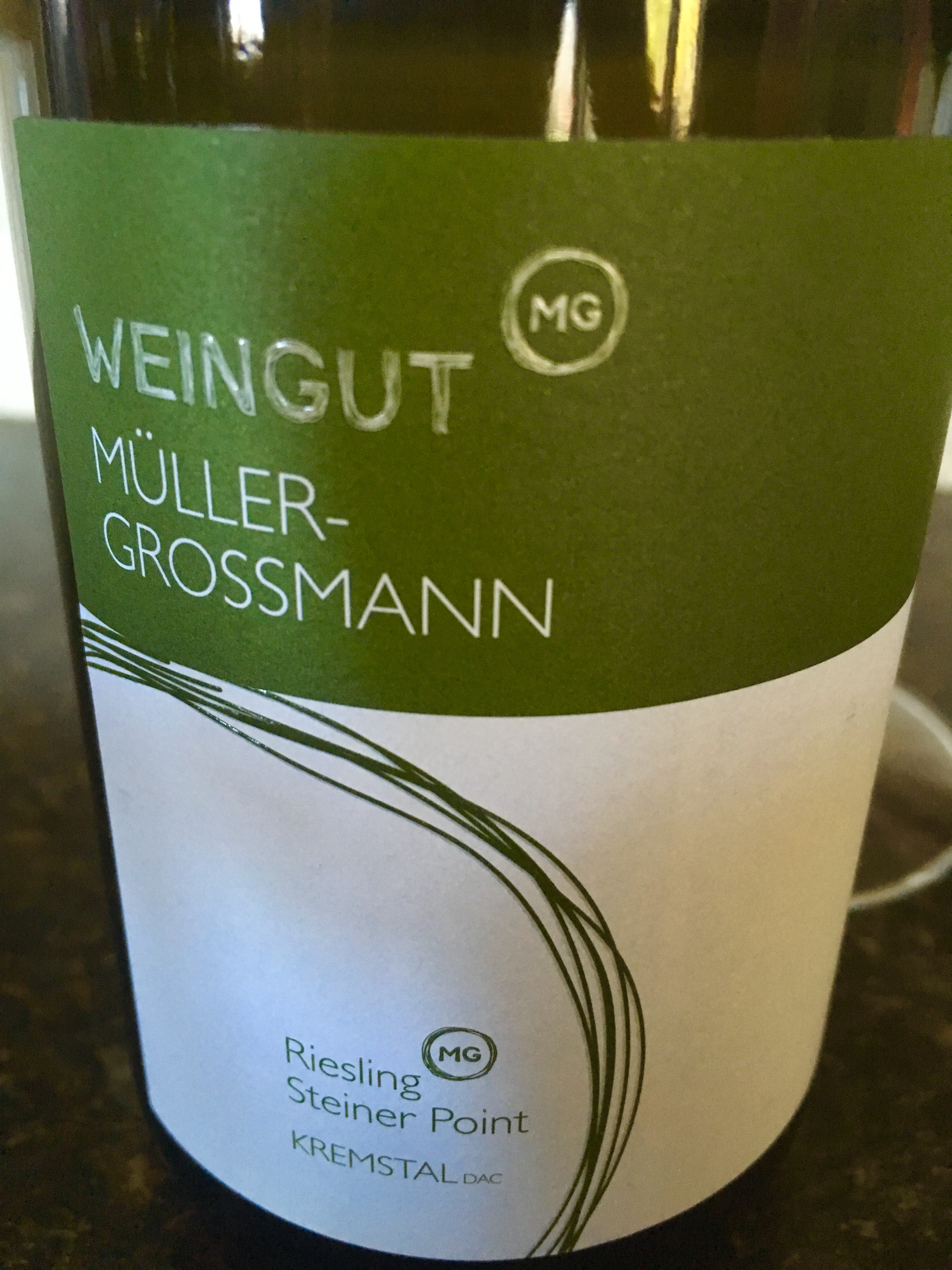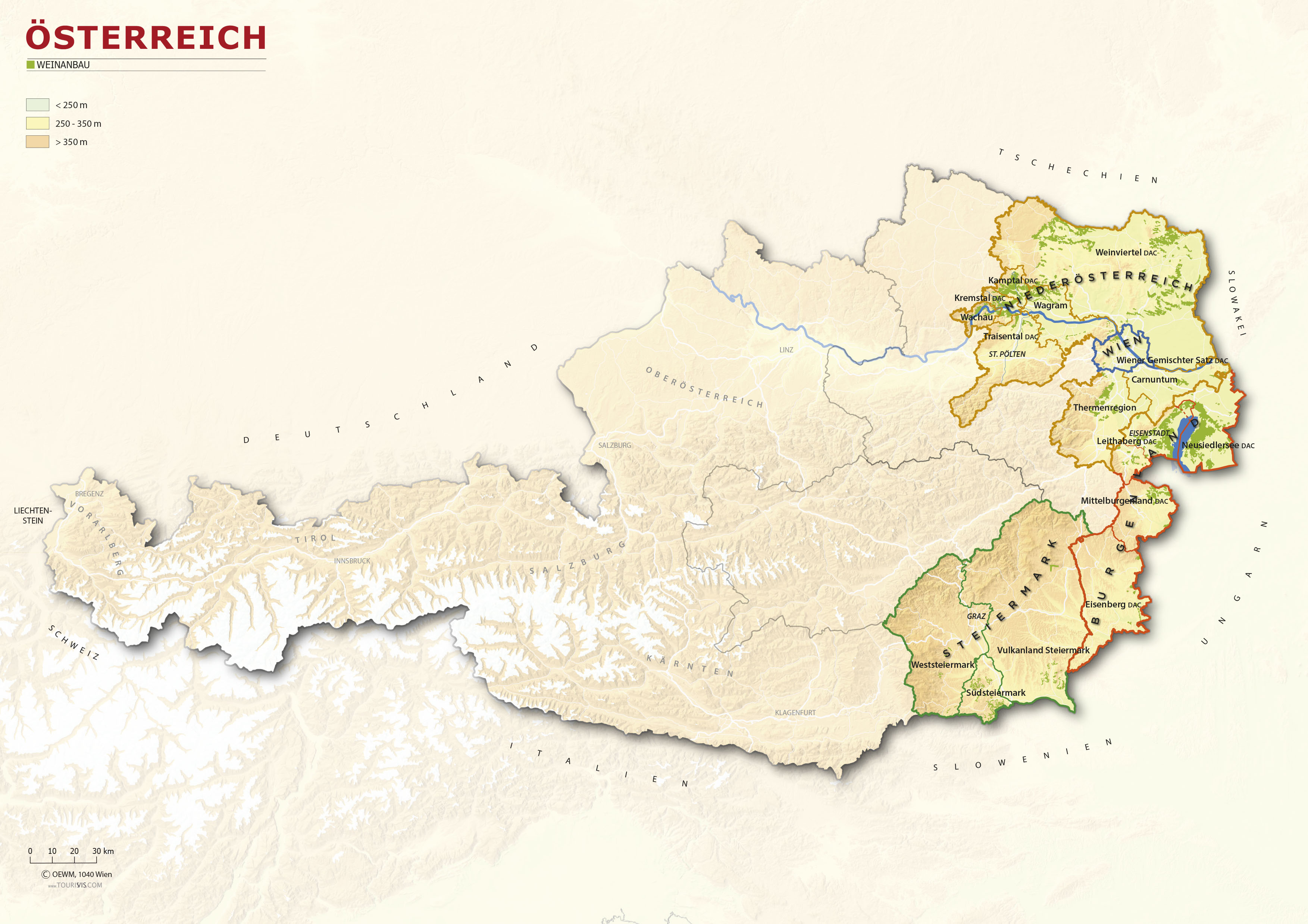Episode 134: Austrian Wine Regional Rap (Part 1)
The hills are alive with the sound of Steph & Val rapping Austrian wine – or wien. Part one gives an overview of the where, who, and when, as well as a grape gab and Austrian crystal factoid.
In Our Glasses
Val:
I have an Austrian Sekt, which, in and of itself is a worthy topic for another episode (hint hint). This is the Steininger Grüner Veltliner, 2013, Flaschengärung, Niederösterreich, Austria.
Steininger = producer
Grüner Veltliner = grape
Flaschengärung = bottle fermented (FLAHShengarung)
Niederösterreich = region ( Nieder = lower; Österreich = Austria)
Steph:
2013 Weingut Müller-Grossmann Riesling – Kremstal DAC ($22.49)
An Austrian bottle I purchased at Supermarket Liquors just for the show!
Weingut = winery
Riesling = grape
Kremstal = wine region
Austrian Wine Region Rap
Geography of Austria (or Österreich)
While some of us may think geography is sexy, it is hard to make it sound sexy on a podcast. Therefore, we’ve included this sexy map, courtesy of AustrianWine.com. *CAUTION: If you are a map geek who gets your kicks from printing out and adulterating wine region maps with colored pencils, you are going to absolutely lose your mind on the maps page of this website. You’ve been warned.*

Map source: http://www.austrianwine.com/facts-figures/maps/
Austria is surrounded by other major wine producing countries and shares borders with Italy, Germany, and Hungary, but its four major wine growing regions are located on its eastern edge next to the Czech Republic, Slovakia, Hungary and Slovenia.
There are four major regions with the most significant and furthest north is Lower Austria, named for its location on the Danube River.
Niederösterreich (Lower Austria)
Lower Austria is further subdivided into eight key wine regions. Among them are four DAC (Districtus Austriae Controllatus) zones – Kamptal DAC, Kremstal DAC, Traisental DAC, and Weinviertel DAC. This is specifically an area of major dry white wine production. Think Grüner Veltliner and Riesling. We’ll be sharing more DAC info later.
Burgenland
South and east is Burgenland, the home of Austria’s famous dessert wines and notable red wines. This area’s major sub-regions are Neusiedlersee (named after Lake Neusiedl) and Mittelburgenland. A key point about this area is the relatively warmer Continental climate here that allows for greater ripening and happy growing conditions for red grapes. Also the lake(s) are a source of humidity to foster botrytis for the super special Ausbruch, Beerenauslese (BA) and Trockenbeerenauslese (TBA) sweet wines. Burgenland has four DAC zones: Mittelburgenland, Leithaberg, Eisenberg, and Neusiedlersee.
Steiermark (Styria)
Steiermark, aka “the Green Heart of Austria,” south of Burgenland, produces a small percentage of wine overall, but has a reputation for quality Sauvignon Blanc and Schilcher rosé. There is one DAC zone here (as of October 2017) called Schilcherland.
Wien (Vienna)
Lastly, there is the city/capital/wine appellation of Vienna, which is surrounded by Niederösterreich subzones and is known for its nouveau style wine called heuriger (pronounced hoy-reh-ga). The one DAC zone here is Wiener Gemischter Satz. Sound familiar? Val mentioned it back in episode 131 when we talked about field blends.
History: Romans, Monks and Scandal
Back in the Day
We roll on over to one of the most awesome regional wine sites out there, AustrianWine.com to seek out interesting history beyond our notes here. While vines can be traced back to this area thousands of years ago, some significant impacts to the Austrian wine culture can date back as far as 700 BC in Burgenland, Weinviertel, and Traisental.
Then, guess who comes along? Yes, the Romans. It seems that they had their fingers in most of wine and beverage history, and Austria was no exception, particularly with respect to the Danube River. Apparently there was a ban on vines in the region and it was the Roman Emperor Aurelius in the 3rd Century that said, “Um, nope,” and sicked his peeps on planting vineyards in the Pannonian plains, the viticultural equivalent of dropping the mic, if you will.
Then there was the mass migration in the 5th century, during which the vineyards were abandoned until viticulture was revitalized under Charlemagne in 8th century.
Send in the Monks
More advancements were made when the (wait for it …) monks (remember, the church had much to do with beverage history pretty much across the board), particularly the Cistercian variety, brought their grape growing swagger to Austria by way of Burgundy from the 10th to the 12th centuries.
It was during this latter phase that regular people were then allowed to play in the viticulture reindeer games by purchasing their own vineyards.
Austrian Firsts
Let’s fast forward a little to the 16th century (or this would be the War and Peace of Podcasts) to some Austrian firsts:
- First, (ha ha) the first sweet wine from Burgenland in 1526, back then called Lutherwein
- 60 years later came the publication of the first German language wine book by Johann Rasch.
- Another important first was the Wine School Klosterneuburg founded in 1860, the first and oldest school for viticulture and enology in the world.
Austrian wine law was written in the 20th century, but it was the wine scandal of the 1980s that severely impacted the Austrian wine industry and the way their quality today is enforced.
The Sweet Smell of … Scandal?
Your ears (or eyes, in the case of this blog) are probably perking up at the word “scandal,” right? What happened was a tragic attempt to gain profit and save money by adding diethylene glycol to mass-produced wines, prompting the establishment of the Austrian Wine Marketing board to reinvent Austrian wine’s image. As a side note, the diethylene glycol is not only found in antifreeze (and highly toxic), but it was thought the wines would be made to taste sweeter.
While not the first wine scandal to rock the wine world, it did make the top 10 in the Drinks Business “Top 10 Wine Scandals” article a few years back. While Austria’s was certainly a dangerous one that resulted in no one dying, it was the Italian methanol scandal the following year that actually killed 23 people and hospitalized more than 90 (Drinks Business, 2011).
Modern Day
What is now Europe’s largest wine school in Rust, the Austrian Wine Academy or Weinakademie Österreich, delivered the first WSET Level 4 Diploma program in German in 1991 (a little nod to the fellow wine educators out there).
Grapes
There are 22 official white grape varieties and 14 red varieties approved for use in classified Austrian wine. Indigenous white grapes such as Grüner Veltliner, Zierfandler and Rotgipfler are special to Austria, but as you’ve heard us mention, international white varieties like Riesling, Sauvignon Blanc and Welschriesling play a significant role in the mix.
Something key to remember is that ⅔ of Austria’s planting are white wine varieties. As for the reds, Zweigelt, by far, is king, but international varieties have made their way to the list too, especially for blending with native varieties. And just so you know, Zweigelt is a cross between St Laurent x Blaufränkisch which was developed in Austria in 1922.
Wine Styles
Often compared to German wines, Austrian wines use some of the same grape varieties and label lingo, but overall trend toward richer, fuller-bodied, remarkably dry white wine styles that still maintain a crisp acidity. Grüner Veltliner is also known for a characteristic herbal or white pepper characteristic.
Yet, their reds can range from elegant Pinot Noir and fruity Blaufränkisch to full-bodied Zwiegelt. Certainly be on the look out for these, as there are some great values as well.
Austria also has a reputation for unctuous sweet wines made with late harvest, botrytized, or ice wine styles, and are also upping their sekt (sparkling wine) game, as we’ll talk about in the next episode.
Learn more…
In Part 2 of our Austrian regional rap, we will be dishing out the details on laws, labels, designations, and sparkling wine. So get ready for that and go buy some Austrian wine already!
References:
Johnson, H., & Robinson, J. (2013). The World Atlas of Wine (S eventh ed.). London: Mitche Beazely.
Robinson, J., & Harding, J. (2015). The Oxford companion to wine (4th ed). Oxford: Oxford University Press.
Robinson, J., Harding, J., & Voui amoz, J. (2012). Wine grapes: A complete guide to 1,368 vine varieties, including their origins and flavours. New York: Ecco.
Stevenson, T., & Avellan, E. (2014). Christie’s world encyclopedia of champagne & sparkling wine. New York: Sterling Epicure.
http://www.traditionsweingueter.at/en/
http://gruppe.schlumberger.at/
http://www.advantageaustria.org/
Factoid
Austria is also famous for crystal! You may have heard of Swarovski or Riedel?
Riedel luxury glassware dates back to the late 1600s with Johann Christoph Riedel who traveled all over Europe trading his glass until he was tragically murdered. Two generations later, Johann Leopold Riedel made a fortune during the 7 Year War making glass window panes and subsequently made major expansions of the family’s glassworks. Joseph Riedel, the 6th generation and “The Glass King of Jizera Mountains”, had sons who eventually in 1895 registered the first Riedel logo. Then, years later, during World War II, Walter Riedel, the 8th generation, struggled amid the chaos, lost everything, and spent 10 years as a prisoner in Russia, to ultimately get help from the Swarovskis and officially rebuild and start Reidel’s mouth-blown glassworks in 1956.
The glasses we know today are the brainchild of the 9th generation Claus Joseph Riedel (1925-2004). His recognition that glass shape affects the perception of alcohol changed stemware forever.
Wino Radar
To wrap-up this Austrian showcase, are you now motivated to visit Austria for wine tourism? We know we are! In January 2016, Austria was named “Europe’s Best Wine Travel Destination.”
Here are some links to get you started.
https://www.fodors.com/news/wine-lovers-guide-to-austria-10850
http://www.nytimes.com/2010/10/17/travel/17journeys.html
http://www.viennaexplorer.com/private-tours/private-bus-tours.php
#W25BookClub
Our next book is a recommendation from Patron and friend Cathey Love in Tennessee. It is the autobiography A Glass Full of Miracles by Mike Grgich.
We love this suggestion Cathey posted on our Facebook community page because of two reasons: Mike’s daughter, Violet Grgich, was a guest on this podcast a year ago in Episode 79; and 2017 marks Grgich Hill’s 40th anniversary.
Also, with regard to the devastating California wildfires, Grgich Hills is safe and open for business.
Reminders:
- Please use the #W25BookClub on social media!
- You can easily order the book right here.
- The Book Review Episode will air on December 21st
*California Wildfire Information*
Recovery efforts are ongoing in California after the devastating wildfires. Here is a comprehensive list of not only these organizations, but ways you can help. As of this posting, this website was just updated on 25 October, 2017: http://www.californiavolunteers.org/index.php/Disaster_Volunteering/current_disasters/
Wine Blogger’s Conference in Santa Rose #WBC17
The Wine Two Five Podcast will be representin’ this year at the Wine Blogger’s Conference: https://winebloggersconference.org/about/ November 9-12, 2017 in Santa Rosa. Please come and say hi!
Shoutouts
We need to give a shoutout to Forvo.com for helping us get through the pronunciations!
Patreon Love
Thank you to our Patrons who support us on our Patreon crowdfunding platform.
“TENacious Tasters”
- Jeff E from the We Like Drinking podcast
- Lynn from Savor the Harvest blog
- Sebastian of Sassi Italy Tours
- Jen in Maryland (and the world, according to her Instagram feed)
- David and Lisa in Illinois
“It’s not five o’clock and we don’t care” Listeners
- Clay in Arizona
- Jon in California
- Andrew in California
- Aswani in California
- Chris and Janet in Colorado
- Diane in Colorado
- Cathie in Georgia
- Steve in Illinois
- Renee in Illinois
- Ashley in North Carolina
- Chantel in Ontario, Canada
- Mary Lou in Pennsylvania
- Meg in South Dakota
- Cathey in Tennessee
“Tastemaker” Listeners
- David in Scotland
- Carole in Kentucky
- Karen in California *Welcome!*
“Winetastic” Listeners
- Laura
Go to our Patreon page for details www.patreon.com/winetwofivepodcast on how to be entered into our monthly drawing, exclusive content, and swag.
Connect
We are here for you every week… and in between episodes, you can find us on the social spaces @WineTwoFive and we encourage you to join our private FaceBook group called Wine Two Five Community!
Connect with Val on Twitter @WineGalUnboxed and as Vino With Val on Facebook, Instagram & Pinterest.
Connect with Steph on Twitter, Pinterest and Instagram as TheWineHeroine.
